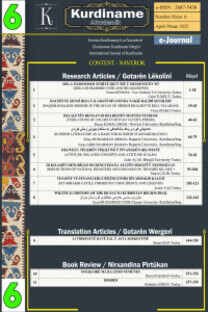نەورۆز لە ڕوانگەی کورد و فارس – لە توێژینەوەیەکی بەراوردکاریدا
نەورۆز لە ڕوانگەی کورد و فارس – لە توێژینەوەیەکی بەراوردکاریدا
The celebration of Newroz/Nowruz at the beginning of spring has a long history among Aryan ethnic groups such as Kurds, Persians, Afghans, Azaris, Tajiks, and Balochs. Newroz, as one of the most important festivals of the ancient Iranians, is a symbol of rebirth, freshness, freedom, and peace. Although its exact date of observance may vary from an ethnic group to another, it mainly occurs between 19th to 21st of March because of its linkage with the Spring Equinox. The festival has been listed among the Intangible Cultural Heritage of Humanity by UNESCO. This study analyzes Newroz according to Kurdish and Persian perspectives. The primary purpose is to investigate diverse cultural perceptions toward the ancient festival among these two nations, and the way they celebrate it. The qualitative research method is used, and semi-structured interviews have been conducted to explore significant differences and similarities between the two nations’ celebrations of Newroz. The participants of the study were selected using the judgmental sampling technique. Results indicate that there are numerous differences in celebrating Newroz. For the Kurds who are a stateless nation, besides its cultural background, Newroz is a symbol of resistance while for Persians it is a pure cultural festival. Even though it marks the beginning of the Kurdish and the Persian new year, their calendars, myths, the way they celebrate it, and their understanding for its origin are different.
Keywords:
Newroz, Kurds, Persians, intangible cultural heritage origin of the Kurds,
___
- Alavijeh, A. Z. (2013) A Comparison between the significance of Number 7 in Persian Context and Number 9 in Chinese Context, ISS & MLB, 1155-1160
- Anwar, K. A. (2016). Kurds and the history of the Newroz feast [کورد و مێژووی جهژنی نهورۆز]. Idea foundation.
- Ashawi, K. (2018). Turkey-backed forces pull down Kurdish statue in Afrin town center: Statement. Reuters. http://tiny.cc/ukwpnz
- Avebury, L. (1996). Turkey's Kurdish policy in the Nineties. The International Journal of Kurdish Studies, 9(1), 1-34.
- Bekas, S. (2013). Writing in an ash water (1) [نوسین به ئاوی خۆڵهمێش]. Iran: Ghazalnus.
- Belyaev, O. (2010). Evolution of case in Ossetic. Iran and the Caucasus, 14, 287-322.
- Berg, B. L., Lune, H., & Lune, H. (2004). Qualitative research methods for the social sciences (Vol. 5). Pearson.
- Bigonah, H. (2016). Nowruz in tradition transition. IIOABJ, 7(3), 491-495.
- Crompton, J., & McKay, S. (1997). Motives of visitors attending festival events. Annals of Tourism Research, 24(2), 425-439.
- Cudny, W. K., Korec, P., & Rouba, R. (2012). Residents’ perception of festivals: A case study of Lodz. Sociologia, 44(6), 704–728.
- Ensaroğlu, Y. (2013). Turkey’s Kurdish question. Insight Turkey, 15(2), 7-17.
- Firdawsi, A. (2006). Shahnameh: the Persian book of kings. Viking.
- Getz, D. (1993). Corporate culture in not-for-profit festival organizations. Festival Management and Event Tourism, 1(1), 11–17.
- .]له ماڵی پیرەمێرد یادی نهورۆز دەکرێتهوە[ Hakim, B. (2016). Newroz is celebrated in the Piramerd house Rudaw. https://www.rudaw.net/sorani/kurdistan/200320166
- Heydari-Malayeri, M. (2004). A concise review of the Iranian calendar. arXiv preprint astro- ph/0409620. Cornell University.
- Hirschler, K. (2001). Defining the nation: Kurdish historiography in Turkey in the 1990s. Middle Eastern Studies, 37(3), 45-166.
- Izady, M. (1992). The Kurds:A concise handbook. Taylor and Francis.
- Jamison, K. (2016). Hefty dictionaries in incomprehensible tongues: Commensurating code and language community in Turkey. Anthropological Quarterly, 89(1), 31-62.
- Janiskee, R. (1980). South Carolina’s harvest festivals: Rural delights for day tripping urbanites. Journal of Cultural Geography, 1(1), 96-104. https://doi.org/10.1080/08873638009478655
- Kaya, Y. (2015). The Opinions of Primary School, Turkish Language and Social Science Teachers regarding Education in the Mother Tongue (Kurdish). Journal of Ethnic and Cultural Studies, 2(2), 33-46.
- Kolcak, H. (2015). A New Constitution for a Stable Nation: A Constitutional Study on the Long- Running Kurdish Question in Turkey. Journal of Ethnic and Cultural Studies, 2(1), .29-48
- KRG. (2020). National holidays and key dates in the Kurdistan region’s history. Department of Foreign Relations. http://dfr.gov.krd/p/p.aspx?p=290&l=12&r=367
- Kvale, S., & Brinkmann, S. (2009). Interviews: Learning the Craft of Qualitative Research Interviewing. Sage.
- Luna, A. M. (2015). A festival’s impact: The case of the Bañamos Festival. International Refereed Research Journal, 6(1), 48-58.
- McDowall, D. (2004). A modern history of the Kurds. London: I.B.Tauris & Co Ltd.
- Okech, R. N. (2011). Promoting sustainable festival events tourism: A case study of Lamu Kenya. Worldwide Hospitality & Tourism Themes, 3(3), 193-202.
- Phillips, D. L. (2017). An uncertain ally: Turkey under Erdogan's dictatorship. London: Routledge. Qeredaxî, N. (2017, March 20). Newroz le efsane û symbulêk wawetir. Ashte. http://ashte.org/index/?p=5298
- Qu, S. Q., & Dumay, J. (2011). The qualitative research interview. Qualitative Research in Accounting & Management, 8(3), 238-264.
- Richter, J. (2005). Iran the culture. Iran: Crabtree Publishing Company.
- Simaei, J. (2008). Nowruz ceremonies, cover 2 [جشن های نوروزی]. Iran: Simro publications. Thrane, C. (2002). Music quality, satisfaction, and behavioral intentions within a jazz festival context. Event Management, 7(3), 143–150.
- UNESCO. (2009). Nomination form. Retrieved July 10, 2019 from http:/fwww.unesco.org/culture/ich/doc/src/00282-Nomination_form.doc
- UNESCO. (2010). The UN General Assembly recognizes 21 of March as the International Day of Nowruz at its sixty-fourth session. http://en.unesco.kz/the-un-general-assembly-recognizes- 21-of-march-as-the-international-day-of-nowruz-at-its
- Woofter, S. (2019). Book Review: Building Equity: Policies and Practices to Empower All Learners. American Journal of Qualitative Research, 3(1), 136- 139. https://doi.org/10.29333/ajqr/5815
- Yanik, L. K. (2006). ‘Nevruz’ or ‘Newroz’? Deconstructing the ‘invention’ of a contested tradition in contemporary Turkey. Middle Eastern Studies, 42(2), 285-302.
- Zamani-Farahani, H. (2013). Cultural heritage events and tourism: A case of NowRuz. Tourism Recreation Research, 38(2), 249-254.
- ISSN: 2687-5438
- Yayın Aralığı: Yılda 2 Sayı
- Başlangıç: 2019
- Yayıncı: Osman ASLANOĞLU
